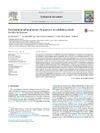Please use this identifier to cite or link to this item:
https://accedacris.ulpgc.es/jspui/handle/10553/106417
| Title: | Polychaete/amphipod ratios: An approach to validating simple benthic indicators | Authors: | Dauvin, J.C. Andrade, H. De-La-Ossa-Carretero, J.A. Del-Pilar-Ruso, Y. Riera, R. |
UNESCO Clasification: | 240119 Zoología marina | Issue Date: | 2016 | Journal: | Ecological Indicators | Abstract: | Among the macro-invertebrates used for the assessment of soft-bottom communities, most polychaetes are classified as tolerant/opportunistic to pollution while amphipods are considered as sensitive. These taxa have been used in several ecological indices, such as the simple abundance ratio between Polychaeta and Amphipoda or the Benthic Opportunist Annelids Amphipods (BO2A) index, to assess the Ecological Quality Status -EcoQs- of soft-bottom communities. In terms of Taxonomic Sufficiency (TS), the polychaete/amphipod ratio (i.e. at the level of the class/order) has been proved to be effective in identifying major changes in benthic communities following disturbances. However, an underlying issue is to assess the acceptable TS limit value needed to state accurately the quality of the benthic environment. We tested three indices using 18 series of observations carried out in five north-eastern Atlantic and Mediterranean zones impacted by oil spills, oil and gas production, brine and urban sewage, harbours and aquaculture farms within impacted and control areas. Similar results to BO2A were obtained when limiting the TS at the level of Polychaete opportunistic families, which required a lower degree of taxonomic expertise, and classifying all amphipods as sensitive taxa. In such a way that the EcoQs given by the BPOFA (Benthic Polychaete Opportunistic Families Amphipods) was very similar to those given by the BO2A (Benthic Opportunistic Annelids Amphipods). | URI: | https://accedacris.ulpgc.es/handle/10553/106417 | ISSN: | 1470-160X | DOI: | 10.1016/j.ecolind.2015.11.055 | Source: | Ecological indicators [1470-160X], v. 63, p. 89-99 |
| Appears in Collections: | Artículos |
SCOPUSTM
Citations
85
checked on Jun 8, 2025
WEB OF SCIENCETM
Citations
79
checked on Jun 8, 2025
Page view(s)
157
checked on Dec 21, 2024
Download(s)
244
checked on Dec 21, 2024
Google ScholarTM
Check
Altmetric
Share
Export metadata
Items in accedaCRIS are protected by copyright, with all rights reserved, unless otherwise indicated.
